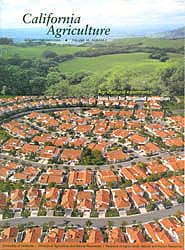All Issues

Agricultural easements:
New tool for farmland
Cover:
To prevent the creep of urbanization into farmland, about 34 land trusts and open space districts have been pursuing agricultural conservation easements in California. While conservation easements have been used to protect natural resources for many years, the use of easements to protect agriculture is relatively new. The first land trust the nation specifically targeting farmland (Marin Agricultural Land Trust) was formed in California in 1980. In recent years, easements have grown in popularity as the preferred farmland preservation tool. The top portion of the cover illustration shows the 519-acre Cook property on Sonoma Mountain, where the Sonoma County Agricultural Preservation and Open Space District (SCAPOSD) purchased an easement that restricts future uses of the land to grazing and possible crop production. Top photo courtesy of SCAPOSD
January-February 2002
Volume 56, Number 1
Volume 56, Number 1





